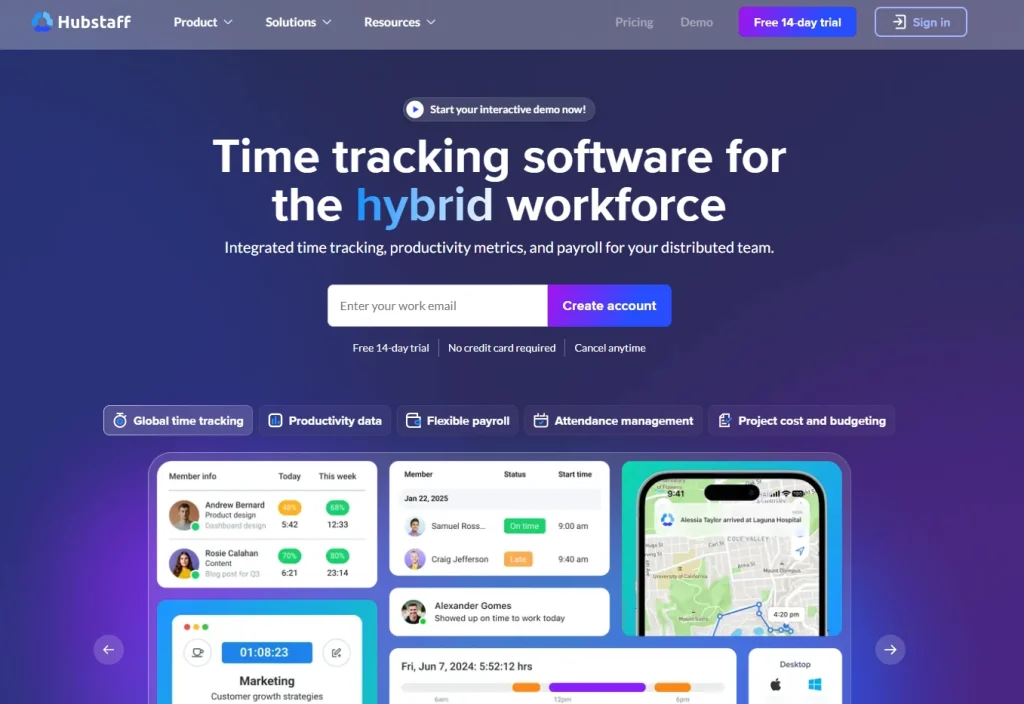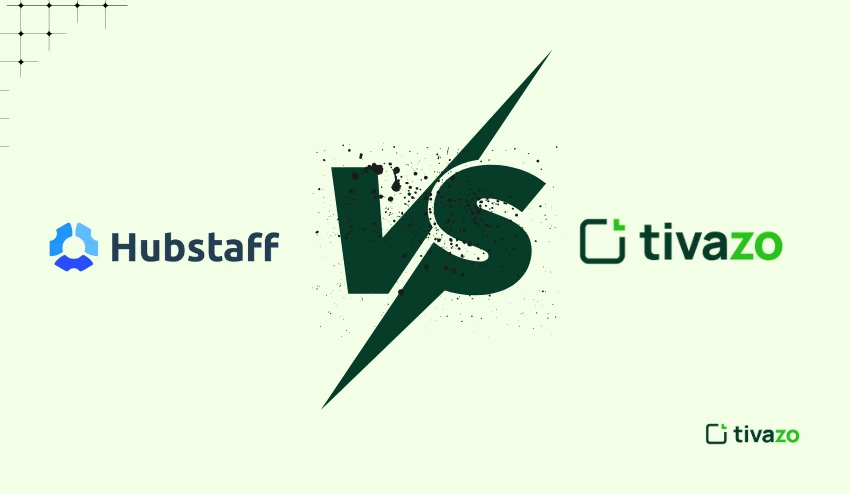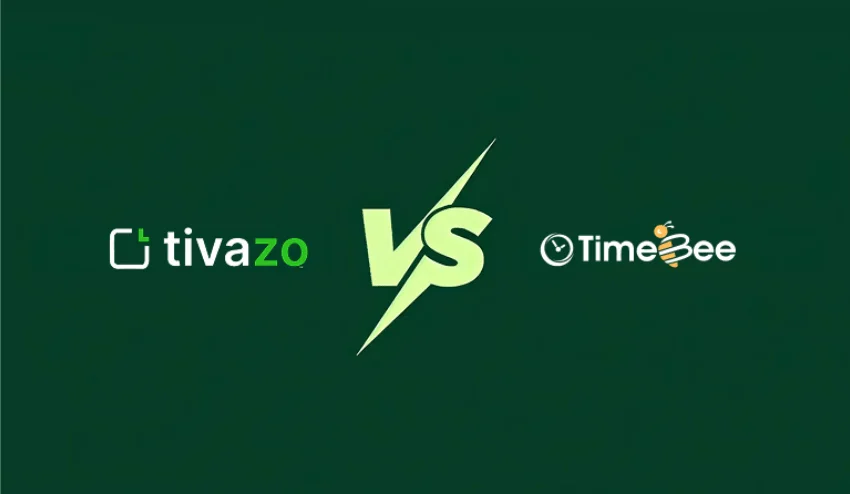When productivity, cost, and user acceptance all matter, finding the right time-tracking software can feel daunting – it’s important to keep clear, however. Many teams settle for Hubstaff because of the name, but the comparison between Tivazo vs Hubstaff is a strong one. Tivazo is a modern, lightweight, and cost-effective alternative worth consideration. In this blog, you will get a thorough and unbiased comparison of Tivazo vs Hubstaff, so you can be sure you are making the right decision for your team (whether that is a certain readiness to act (transactional intent) or merely just finding.
Quick comparison table
| Feature or aspect Comparison | Tivazo (Tivazo vs Hubstaff) | Hubstaff(Tivazo vs Hubstaff) |
| Ease of use | Simple, quick setup with a clear user interface ✅; minimal learning curve | Complex interface; steep learning curve, multiple modules to navigate. |
| Pricing | Affordable plans; upfront, flat-rate pricing; good value for SMBs | More expensive; tiered pricing; many essential features behind paywalls |
| Features | Straightforward time tracking, task reporting, and employee accountability | Heavyweight: time tracking, payroll, GPS, screenshots, invoicing, advanced analytics |
| Integrations | Connects to essential apps; small ecosystem, quick setup | 35+ integrations: Slack, Asana, and QuickBooks are complex |
| Setup | Support, Fast, personal support; dedicated response. | Slower support response; mixed reviews; support can be impersonal |
| Best For | SMBs, lean teams needing simplicity and efficiency | Enterprise, remote-heavy teams, compliance-focused businesses |
| Reporting & Analytics | Clear, easy-to-interpret dashboards; can see key metrics all at once | Advanced analytics; customizable reports; more detail, may require more effort to decipher. |
| Mobile App User Experience | Lightweight app with basic task and time tracking features on the go | Full-featured app, may be heavier and slower; offers more functions for enterprise tracking |
| Employee User Experience | Encourages accountability, without being intrusive | Have monitoring capabilities such as screenshots and GPS, which could be seen by some employees as intrusive |
| Setup & Onboarding | No configuration at all, and teams can start tracking in hours | The setup is a little more complicated and may need to have training and admin setup |
| Security & Privacy | GDPR compliant, and an emphasis on employee privacy | Has very strong security features, and in-depth monitoring may raise employee privacy concerns. |
| Scalability | Perfect for small to mid-size teams | More suited for large enterprises and complex organizational structures |
Hubstaff Overview
Hubstaff is a well-known, comprehensive workforce management tool since its establishment in 2012. Its versatility is largely one of the main factors in its success, as organizations with remote teams gravitate towards using Hubstaff due to its overflowing assortment of features. Hubstaff facilitates robust time tracking, automatic payroll, activity levels monitoring, screenshots, GPS tracking, and project management. Hubstaff also provides dozens of integrations to apps like Slack, Asana, QuickBooks, Trello, and Jira, making it quite versatile for complex organizational needs.

Pros:
- Comprehensive reporting and productivity metrics that provide managers with granular insights about their team’s performance
- Full operational view with payroll, invoicing, scheduling, and GPS tracking.
- All the important integrations keep enterprise workflows efficient.
Cons:
- Costs can rapidly escalate if the feature set grows, which causes users to frequently engage multiple paid tiers, causing some extra confusion.
- Some of the monitoring features (i.e., screenshots or GPS) could feel intrusive for users and come off as an invasion of privacy.
- UI is not exactly intuitive or simple, particularly for those less comfortable around tech, making the learning curve longer.
- The variety of features could feel unnecessarily complex compared to possible options with fewer features.
In the debate between Tivazo vs Hubstaff, many small and mid-level teams find Hubstaff’s advanced tools robust but possibly too many features. The Tivazo vs Hubstaff question is often a well-defined debate between simplicity and depth: Tivazo delivers ease of use and core productivity features, whereas Hubstaff delivers deep monitoring and enterprise-level value.
Tivazo Summary
Tivazo is a new, small, simple, and inexpensive time tracking option. Tivazo has a focus on simplicity, employee ownership, team assessment in real-time, and ease of use. Tivazo does not overload your users with excessive features like other time tracking platforms and does not track users in a big brother way, so teams potentially wanting a productivity tool that is not so intrusive can use Tivazo confidently.
Strengths:
- Clean, user-friendly UX with little to no onboarding or setup needed, making the launch pretty easy, allowing teams to start tracking time in a matter of minutes.
- Simple and transparent pricing for usage, allowing businesses of all sizes, particularly small and medium-sized companies have a feasible option.
- Time tracking, accountability, task reporting, and performance insights, kept simple and uncluttered, which is a key to Tivazo’s platform.
- Create an atmosphere of trust and ownership rather than all-knowing surveillance, which can enhance employee happiness.
- Reports are quick, and the dashboards allow managers to efficiently review productivity and assess critical information about their teams.
When companies are comparing Tivazo vs Hubstaff, companies in SMB and growth stages have typically appreciated the simplicity of Tivazo. The consensus of comparing Tivazo vs Hubstaff demonstrates that while Hubstaff does offer monitoring features, designed for enterprise businesses, Tivazo provides a lightweight and practical solution that allows organizations to manage usability, cost, and employee experience.
A Direct Comparison
1. Ease of Use
- Tivazo: Tivazo makes it easy to get going with clean navigation, intuitive dashboards, and instant understanding. Any team can start tracking their time by being tech-friendly. Non-technical people can use it easily, making it user-friendly.
- Hubstaff: Powerful option, but the UI and setup take more time and learning. You have multi-layer combinations of modules, menus, and advanced settings to work your way through as a new user.
2. Pricing
- Tivazo: Tivazo offers a flat, reasonable plan designed for SMBs that is affordable, gives essential productivity features, and has no hidden fees. Transparency in what is included from a pricing structure perspective makes it easier for teams to budget and scale gradually.
- Hubstaff: So many tiers; you can burn through pricing quickly when advanced features, like GPS, payroll automation, or screenshots, become necessary. Smaller teams that are seeking to stub out a powerful dialed workflow may find this option costly and an unnecessarily complex booking process.
3. Features
Tivazo: The essentials of time tracking, task reporting, and basic productivity evaluation make it easy for teams to stay focused and productive without all of the distractions.
Hubstaff: A Heavy suite of tools, including GPS, screenshots, payroll, scheduling, and workforce analytics. Although powerful, these features often become irritable (and even intrusive) to smaller teams or teams looking for something simple and effective.
4. Usage
Tivazo: As a metric is different than performance, the market is made up of business teams who value usable and fast-to-implement over feature-rich and customized. Tivazo gets all members of the team, regardless of their technical or IT capabilities, up and running quickly with the system. Tivazo vs Hubstaff
Hubstaff: though it enabled front-line teams to implement robust monitoring, training leaders could hardly go with them, and this would be the case with larger organizations that had specific monitoring needs.
5. Best For
- Tivazo: Tivazo’s simplicity and quick adoption are ideally suited for SMBs, fast-growing teams, or managers who want to respect employee privacy.
- Hubstaff: Enterprises want to get deep controls, monitoring, and full automation. Gaining knowledge of the Tivazo vs Hubstaff experience.
6. Customer Support
Tivazo: Regarding support, Tivazo offers fast access, friendly service with customized requests so teams can access solutions effectively.
Hubstaff: Conversely, frontrunning, we have heard that support issues arise slowly and disingenuously, can be slow for billing questions, etc., and simply getting a response can many times take longer.
Moreover, Tivazo vs Hubstaff is often a matter of trust vs control: Tivazo allows employees to be accountable for their time without heavy monitoring, whilst Hubstaff gives you oversight of everything, which many smaller or privacy-conscious teams may see as overkill.

When To Choose Hubstaff
Hubstaff is the best option if you have enterprise-level visibility requirements. In the Tivazo vs Hubstaff comparison, Hubstaff stands out when strict tracking, compliance, and flexibility are required. Consider Hubstaff if:
- You need enterprise-level accountability if you have a larger team with multiple workers in remote roles. Hubstaff has a unique combination of GPS tracking, in addition to screenshots and activity measurements.
- Payroll and invoicing are important: Hubstaff funnels payroll with time tracking and minimizes human involvement when billing customers, allowing you a focus on executing the customer’s orders.
- You need strict project management: If you want your team by scope and time to completion or different task completion to gauge project viability, Hubstaff has a comprehensive project planning structure.
- Compliance-heavy industries: If your organization is fraught with compliance-heavy sins or requires tracking for audit logs, Hubstaff provides you with reporting logs of the past 3 months.
- You need heavy integrations: Hubstaff has over 35 integrations to work with, so if you want a Heavyweight Management platform integrated with Slack, Asana, QuickBooks, and Jira integrations, Hubstaff is a good fit.
In the case of the Tivazo vs Hubstaff dilemma, most enterprises with some complicated operational oversight work are more centralized toward Hubstaff standards. The focus of Tivazo is simplicity. The focus of Hubstaff is a powerful platform that supports large teams requiring oversight and structured requirements.
When to Use Tivazo
Choose Tivazo when:
- Your most important consideration is speed and ease for employees. Teams can begin tracking time immediately without a complex setup, eliminating unnecessary delays for their onboarding.
- You want unequivocal, clear pricing for your usage of products. Tivazo has one low and affordable price for every plan with no hidden fees, which makes budgeting easy. For SMB’s and growing teams, it’s easy to identify potential costs.
- You want people to experience trust over surveillance. While Tivazo vs Hubstaff monitors employees with screenshots and GPS, Tivazo encourages better cultural practices throughout your organization by demonstrating accountability over surveillance.
- You want effective time tracking without over-complicated solutions. Tivazo’s focus on the core functionality of time tracking, task reporting, and employee reviews provides enough value to drive productivity without distraction.
- You want a minimal learning curve and to get employees using Tivazo as quickly as possible. The intuitive dashboards and simple-to-navigate dashboards help employees love using the system very quickly.

While evaluating Tivazo vs Hubstaff, we consistently hear from small and mid-size teams how the simplicity of Tivazo outweighs Hubstaff. For the Tivazo vs Hubstaff debate, it often gets down to features and usability – Hubstaff features tend to be heavier on organizational controls and monitoring, more typical of enterprise applications, while Tivazo features are focused more on usability, employee happiness, and costs. For teams that are continually “improving” and considering time tracking products like Tivazo vs Hubstaff to demonstratively prove productivity, it ultimately comes down to what they are valuing in producing performance and productivity.
Conclusion
Tivazo vs Hubstaff: with Hubstaff in the discussion, which is best known for the advanced, enterprise features – and can therefore overwhelm and create more costs, and Tivazo, which is arguably the smarter solution for lean teams – simple, cheap, productivity focused, and recognizes user experience. Then there is the case for most SMBs that Tivazo is a well-balanced, modern solution.
The decision for managers to switch from Tivazo vs Hubstaff often comes down to team size, complexity, and priorities. In general, small and mid-sized teams that value ease of use, adoption, and cost-effectiveness are more likely to choose Tivazo, while larger enterprises looking for detailed monitoring and extensive integration choices, until now may go with Hubstaff. The side-by-side comparison of Tivazo vs Hubstaff aims at managers’ pain points and what best provides a decision of which application best suits their detailed workflow and culture.
Start tracking with Tivazo today – free trial available!




